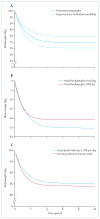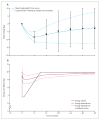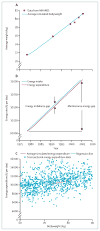Quantification of the effect of energy imbalance on bodyweight
- PMID: 21872751
- PMCID: PMC3880593
- DOI: 10.1016/S0140-6736(11)60812-X
Quantification of the effect of energy imbalance on bodyweight
Abstract
Obesity interventions can result in weight loss, but accurate prediction of the bodyweight time course requires properly accounting for dynamic energy imbalances. In this report, we describe a mathematical modelling approach to adult human metabolism that simulates energy expenditure adaptations during weight loss. We also present a web-based simulator for prediction of weight change dynamics. We show that the bodyweight response to a change of energy intake is slow, with half times of about 1 year. Furthermore, adults with greater adiposity have a larger expected weight loss for the same change of energy intake, and to reach their steady-state weight will take longer than it would for those with less initial body fat. Using a population-averaged model, we calculated the energy-balance dynamics corresponding to the development of the US adult obesity epidemic. A small persistent average daily energy imbalance gap between intake and expenditure of about 30 kJ per day underlies the observed average weight gain. However, energy intake must have risen to keep pace with increased expenditure associated with increased weight. The average increase of energy intake needed to sustain the increased weight (the maintenance energy gap) has amounted to about 0·9 MJ per day and quantifies the public health challenge to reverse the obesity epidemic.
Copyright © 2011 Elsevier Ltd. All rights reserved.
Conflict of interest statement
We declare that we have no conflicts of interest.
Figures






Comment on
-
The future challenge of obesity.Lancet. 2011 Aug 27;378(9793):743-4. doi: 10.1016/S0140-6736(11)61261-0. Lancet. 2011. PMID: 21872734 No abstract available.
-
Reversing the tide of obesity.Lancet. 2011 Aug 27;378(9793):744-6. doi: 10.1016/S0140-6736(11)61218-X. Lancet. 2011. PMID: 21872735 No abstract available.
-
Where next for obesity?Lancet. 2011 Aug 27;378(9793):746-7. doi: 10.1016/S0140-6736(11)61272-5. Lancet. 2011. PMID: 21872736 No abstract available.
References
-
- Butland B, Jebb SA, Kopelman PG, et al. Foresight tackling obesities: future choices—project report. 2. London: Government Office for Science; 2007. - PubMed
-
- Hill JO. Understanding and addressing the epidemic of obesity: an energy balance perspective. Endocr Rev. 2006;27:750–61. - PubMed
-
- Duyff RL. American dietetic association complete food and nutrition guide. 3. Hoboken: John Wiley & Sons Inc; 2006.
-
- NHLBI. Aim for a healthy weight: National Institutes of Health, National Heart, Lung, and Blood Institute. 2005. Report No: 05-5213.
-
- The practical guide: identification, evaluation, and treatment of overweight and obesity in adults. National Institutes of Health; National Heart, Lung, and Blood Institute; North American Association for the study of obesity; 2000. NHLBI obesity education initiative expert panel on the identification evaluation, and treatment of overweight and obesity in adults.
Publication types
MeSH terms
Grants and funding
LinkOut - more resources
Full Text Sources
Other Literature Sources
Medical
Miscellaneous

